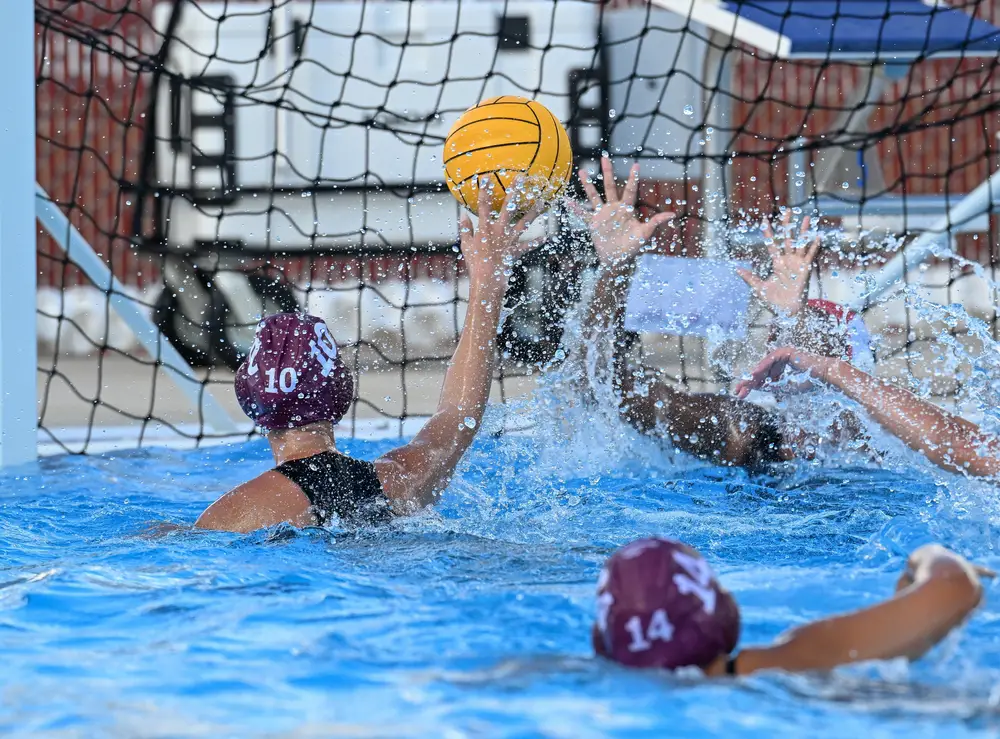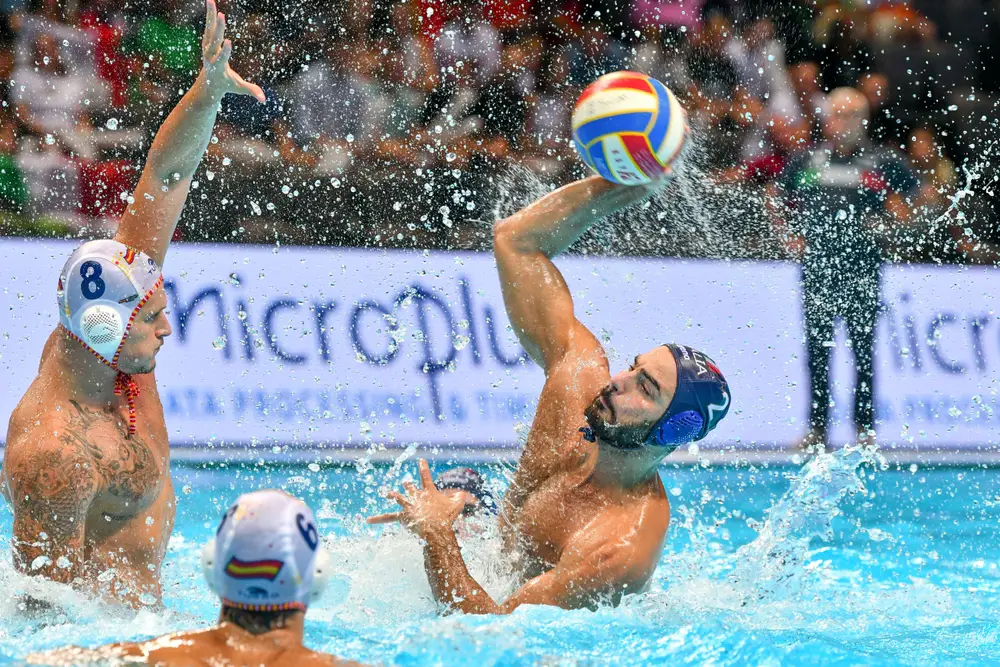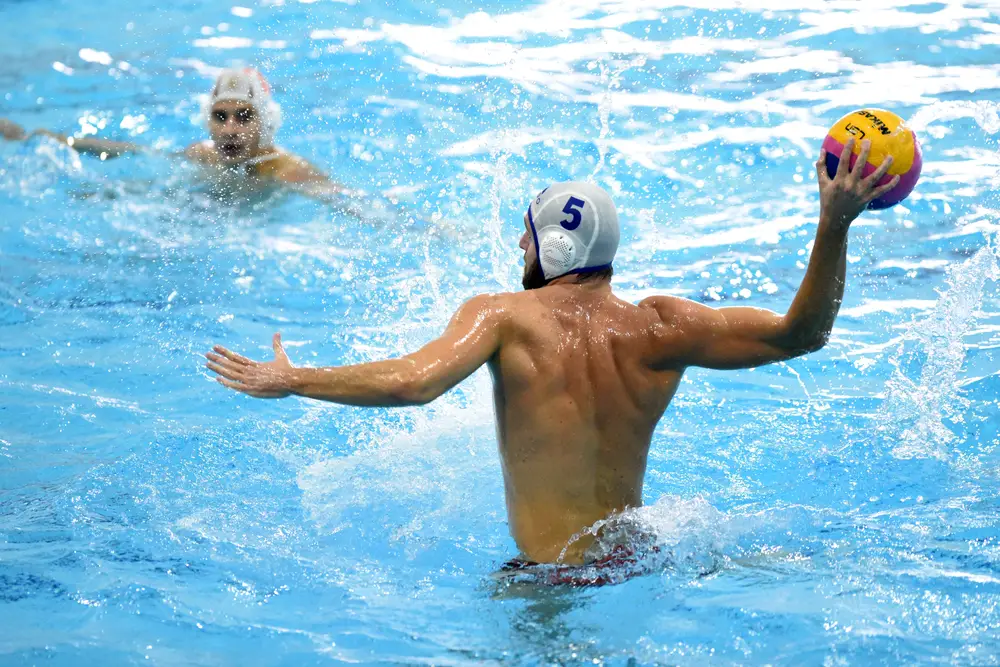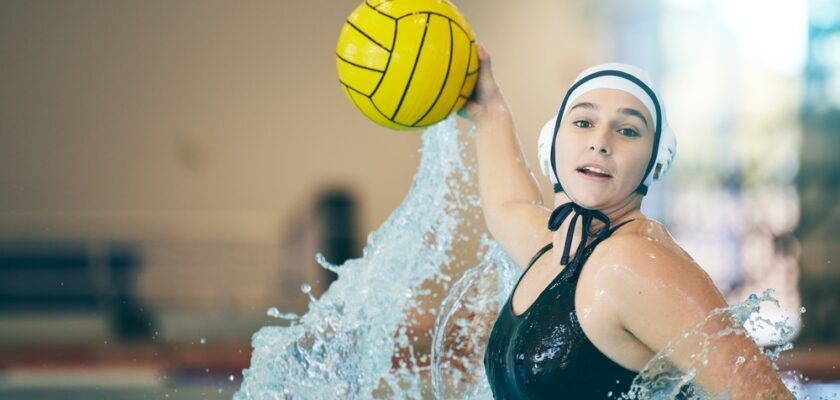Water polo is a team sport that combines elements of swimming, handball, soccer and even basketball, requiring skills such as strength, endurance, agility and teamwork. The sport is played in a pool with a ball, where two teams of seven players compete to score goals against their opponents.
If you like the sport and want to know more about it, then it’s time to check out the glossary of water polo. By understanding its main terms, whether you’re a player or a sports enthusiast, you’ll better understand the rules, techniques, strategies and positions that are essential to the development of the game.
Check out the sport’s main terms in the water polo glossary!

Open your Betano account and get up to 1,000 reais in bonuses.
PIX payments, live games and super odds!
Click here to open your account!
Water polo glossary: complete list
See the terms covered in the water polo glossary!
- Referee
- Penalty Throw
- Assist
- Blocking
- Water Polo Ball
- Water Polo Stroke
- Cap
- Center forward
- Counter-attack
- Zone Defense
- Exclusion (Temporary Expulsion)
- Ordinary Foul
- Severe Fault
- Floating
- Goalkeeper
- Goalkeeper
- Two Meter Line
- Seven Meter Line
- Marker
- Exit Swim
- Swimming Pool
- Ball possession
- Pressing
- Substitution
- Throwing Techniques
- Time-Out
- Corner kick
- Goal kick
- Free kick
- Five Meter Zone
Water polo glossary: learn more about the terms
Get to know the terms that are part of the water polo glossary!
Referee
The first term covered in the water polo glossary is referee, the official who oversees the game, applying the rules in the right way and ensuring that the match runs smoothly. There are usually two referees in a water polo match.
Penalty throw
The penalty throw is awarded after serious fouls within the five-meter area. The player has a direct shot on goal without interference from the defense.
Assist
The assist is the name given to the pass that leads directly to a goal, and is an essential component of successful attacking play.
Blocking
Blocking is the action of intercepting or deflecting a shot on goal, which is done by defensive players or the goalkeeper.
Water polo ball
The ball used in water polo is made of synthetic material and has a rough texture that makes it easier to grip when it’s wet. The men’s ball has a circumference of 68-71 cm and weighs between 400-450 grams, while the women’s ball is slightly smaller and lighter.
Water polo stroke
The water polo stroke is the swimming technique used by water polo players, allowing them to swim quickly with their heads out of the water to keep an eye on the game.
Cap
The cap is the name given to the cap worn by the players for identification and protection. It has specific numbers and colors to distinguish between the players on each team.
Center forward
The center forward is the offensive player who occupies a position close to the opponent’s goal, centered on the six-meter line. This player is essential for finishing plays and scoring goals, using his strength and skills to overcome the opposition’s defense.
Counter-attack
The counter-attack is a quick offensive strategy that happens when possession is won and the team immediately advances towards the opponent’s goal, trying to score before the defense reorganizes.
Zone defense
Zone defense is a strategy in which defenders cover specific areas of the pool instead of marking opponents individually. This provides broader and more efficient coverage.
Temporary ban
A temporary ban is a punishment given to a player who commits a serious foul, resulting in them being taken out of the game for 20 seconds. During this time, the team plays with one less player, giving their opponents an advantage.

Ordinary foul
The common foul is a minor infraction resulting in a free kick for the opposing team. These fouls are frequent and are part of the dynamics of the game.
Serious foul
A serious foul results in the temporary exclusion of the player who committed it. It happens after actions such as pulling, pushing or dunking the opponent in an unsportsmanlike manner.
Floating
Buoyancy is the ability to stay on the surface of the water, essential for passing, shooting and effective defense during the game.
Goal
The goal is the rectangular structure on which the players try to score points. It measures three meters wide by 90 centimeters high, and is fixed at the ends of the pool.
Goalkeeper
The goalkeeper is the player responsible for defending his team’s goal. Their main function is to prevent the ball from entering the goal, using both their hands and feet to block shots. The goalkeeper is the only player who can touch the bottom of the pool and hold the ball with both hands within his five-meter area.
Two-meter line
The two-meter line is a restricted area where players cannot be without the ball. It is used to avoid crowds in front of the goal.
Seven-meter line
The seven-meter line is a mark in the pool used for certain throws and infractions. Penalties, for example, are charged from this line.
Marker
The marker is a defensive player who has the responsibility of marking the opposing center forward. This player uses containment and blocking techniques to prevent the center-forward from receiving the ball or taking shots on goal.
Outswimming
The exit swim takes place at the start of each period, when the players swim quickly to gain possession of the ball placed in the center of the pool.
The pool
The water polo pool has dimensions of 30 meters long by 20 meters wide for men, and 25 meters long by 20 meters wide for women. The minimum depth is 1.8 meters.
Ball possession
Ball possession is the name given to a team’s control of the ball. Each possession lasts a maximum of 30 seconds, after which the ball must be shot at goal.
Pressing
Pressing is a defensive technique where players mark their opponents closely, making it difficult for them to pass and shoot.
Substitution
Substitution allows players to enter and leave the game during interruptions and is fundamental to keeping the team rested.
Throwing techniques
Throwing techniques refer to the different ways of throwing the ball, including the shoulder throw, wrist throw and lob (high and slow throw).
Time-out
A time-out is a break requested by the coach to allow the players to rest and receive instructions. Each team is entitled to two one-minute time-outs per game.
Corner kick
The corner kick is awarded when the ball goes over the end line, having been touched by a defender other than the goalkeeper. The shot is taken from the corner of the pool.
Goal kick
The goalkeeper takes a free-kick when the ball goes over the goal line after being touched by the attacking team.
Free kick
The free kick exists after a common foul and must be taken from the spot where the infringement occurred, allowing play to continue quickly and dynamically.
Five-meter zone
The five-meter zone is the area in front of the goal that has some specific rules, such as the prohibition of direct shots after common fouls.

Water polo glossary
Now that you know the glossary of water polo, you’ll be better informed about the sport and how it works. And if you liked this article, keep exploring the site to check out our content on this and many other sports.Also, leave a comment telling us what you thought of the article and the main terms in the water polo glossary.



